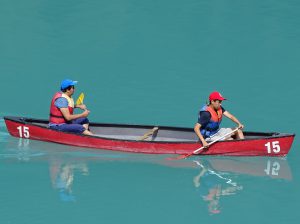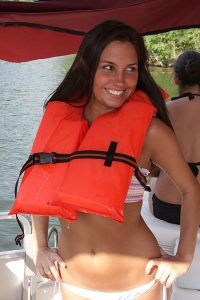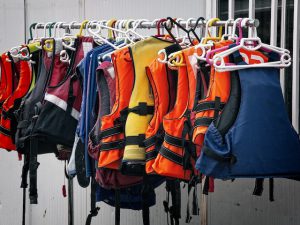I remember when I was in the Boy Scouts, we were not allowed to call them “lifejackets”, because that implied it would save your life. We were taught to call them PFD’s (Personal Flotation Devices) because their job was to help you float, which may or may not be enough to save your life. That was an important distinction that helped us be prepared for other water issues, like hypothermia or head trauma. So in this article, I’m going to take literary license and call lifejackets, PFD’s

California law (and I think basic decency) requires that every child younger than 13 must wear a PFD at all times while on a moving vessel less than 26′ in California. Some states have a different requirement. On my boat it has always been 14. I don’t have any proof for the distinction, I have just always felt it should be 14, so on my boat that’s my rule. (as long as my rules are not less stringent than the law, I have that right) The PFD should of course be of the appropriate size for that child. In my opinion, if you have a kid under about 5 who likes to climb and run and, well, be a kid, it’s not the worst idea to tether the PFD with a line as well, so if they do go in, it is easier to get them out. But what about the rest of you on board?

To meet U.S. Coast Guard requirements, a recreational vessel must have a U.S. Coast Guard Approved PFD for each person aboard, and that means one that would fit each person. If you have 3 adults and 2 children, 5 child sized PFD’s (nor 5 adult sized PFD’s) would suit each person aboard. And they must be easily accessible (not in a closed and latched compartment). So you and your loved ones are in a boat and the PFD’s have to be accessible, which means they might be on a seat, where they are potentially in the way of sitting and relaxing or even subject to blowing out of the vessel with a nice breeze… hmmm… how to solve that issue. Well if you put it on, it won’t be in the way or blow out, of course it won’t help your tan line either, so there are 2 reasons to put it on and one not to. Oh, and are you one of those boaters who does not even keep them handy? Well the local governing body of your waterway can (and I have seen them do it) issue steep fines, so I suggest you at least do that.

originally posted to Flickr as Goofy Orange Life Jacket Model
Many responsible boating organizations will say ‘always’ wear your PFD, and I say ‘always’? And they say, OK smarty pants, ‘always when boating’ so I say ‘always when boating?’ and they say ‘YES!’ And I say, ‘always when I am boating and anchored and below deck?’ and they say, ‘well, ok, maybe not’ and then I say ‘what about when I’m boating on a cruise ship? Or the San Francisco Bay Ferry?’
So I was reading this one blog and the writer says he recommends ‘Whenever on the water on a vessel of any kind, alone’ and I cringed… please don’t boat alone. We all think nothing bad will ever happen to us, but bad things happen, so I implore you to never boat alone. Some of you are thinking ‘but what about a one-person kayak, you do that alone’ and I would respond, ‘not if there are 2 of you, each in a one person kayak… now you’re not alone and if something goes wrong there is someone to potentially help you or call for help, or at least tell the authorities what happened.’
OK, I’m off my soapbox for now, but you may want to read about the one time I went ‘alone’

Look, if you’re over 18, you’re gonna do whatever you want, however, in my opinion, you should strongly consider wearing a PFD when recreational boating, even if it will hurt your tan line, under the following circumstances.
If you are not a strong enough swimmer to swim for 30 minutes without touching a floor of some kind (the bottom of a pool or rocks or sand)
If the water temperature is below 70 degrees
If the boat is not very stable (like a kayak or canoe)
IF the weather could be considered ‘foul’
Here is something you should know before I go farther: According to the U.S. Coast Guard, half of all recreational boating fatalities happen in calm water. And all are unexpected.
And finally, in any other situation where someone has a ‘bad feeling’ you should strongly consider wearing a PFD when recreational boating. Human’s have amazing intuition, and often the first indication of actual danger is someone’s ‘bad feeling’. Those should not be ignored. I just hope they speak up when they have that feeling.
To wrap it up, PFD’s do help save lives and I hope you never need yours.
Fair Winds
Captain Jeff Vegas
Watch video testimonials for Captain Jeff Vegas by clicking this link
 Terms of Use
Terms of Use
[…] are worth reiterating for travel at night; Check tide and weather reports before shoving off. Keep flotation devices in an easily accessible […]